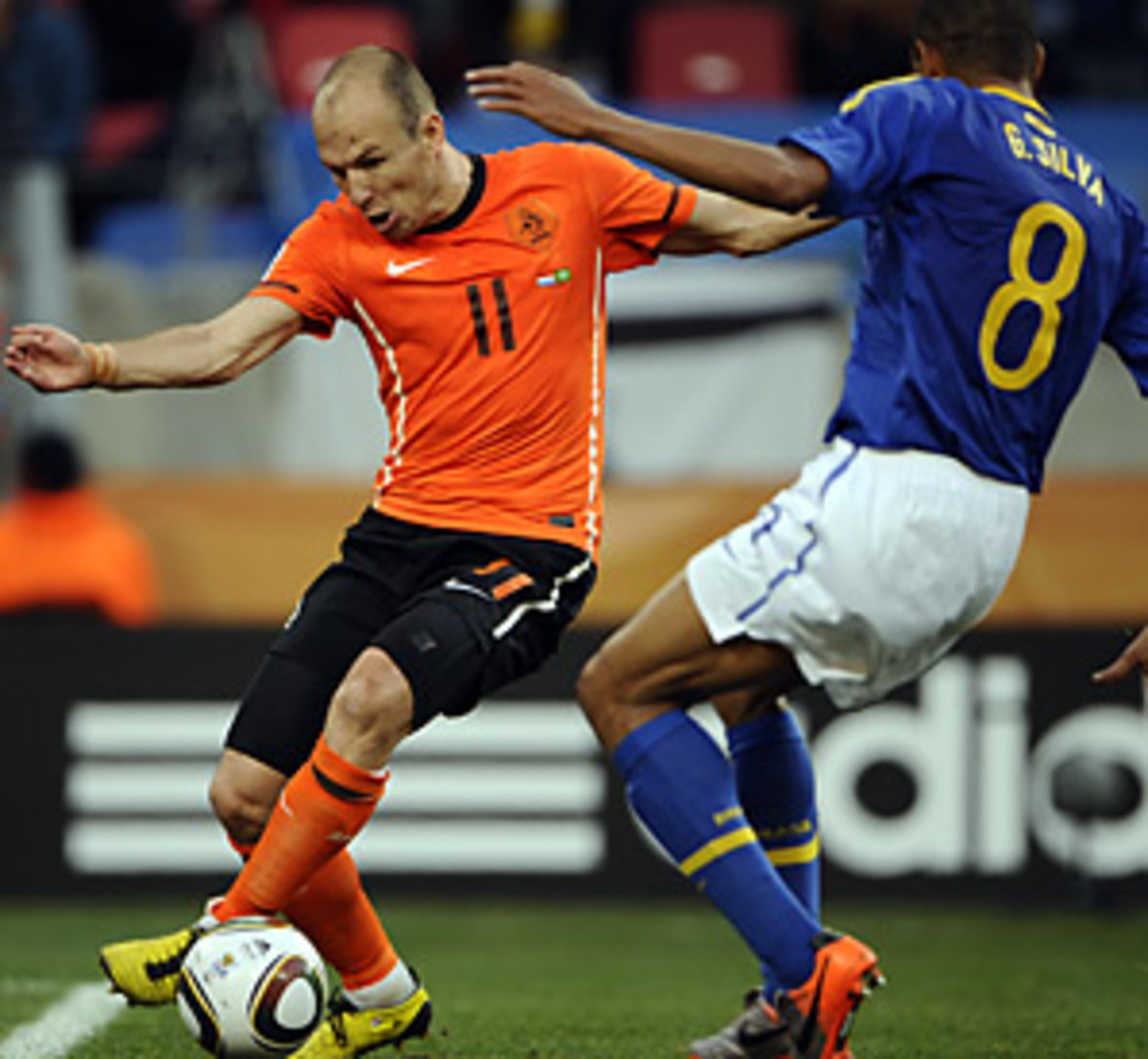Uruguay, Netherlands' lineups will be hindered by key suspensions
(As an aside, what should happen with suspensions is quite simple; cancel all the yellow cards from the group matches after the second round, then players never have a game in which they can pick up a yellow with impunity, knowing it's about to be cancelled, while also lessening the risk of players missing the semis and finals because of collecting two yellow cards for trivial or technical offenses).
The Netherlands is without the midfield anchor Nigel De Jong and the right-back Gregory van der Wiel. The latter will probably be replaced by Khalid Boulahrouz, which would usually be a risk given his vulnerability to players who can run at him. However, in this instance it may not be a problem as Uruguay doesn't really have anybody in that mould on the left, particularly now Nicolas Lodeiro has been ruled out of the tournament after fracturing a bone in his foot. (I first saw Boulahrouz when, killing time one Friday night in the Netherlands, I went to a Dutch league match between RKC Waalwijk and PSV Eindhoven; he was shredded by a rapid balding left winger with an old man's gait -- the 19-year-old Arjen Robben). Uruguay have the option of switching Edinson Cavani to the left to try to expose Boulahrouz's flat-footedness, but that raises problems in terms of the structure of Uruguay's defending.
Uurugay has also lost a fullback through suspension: Jorge Fucile, who has arguably been the best left back in the tournament so far. That probably means Martin Caceres filling in. Caceres spent last season on loan at Juventus from Barcelona, and is more usually a center back, but he is the only real option Uruguay coach Oscar Washington Tabarez has unless Alvaro Pereira were to be dropped back from midfield to expose Boulahrouz to Cavani . The priority, though, is to stop Robben, who has been the one Dutch creator really to look anything like his best in this tournament, so logic would suggest Caceres should come in on the left of the back four, with Pereira offering support, particularly given the problems in the centre of defense. Caceres is also capable of playing at right back, which may be an advantage in that Robben, playing as a left-footer on the right, will be attacking Caceres on his right foot.
Both Diego Godin and Diego Lugano, the captain, are injury doubts, so a safety-first approach seems most likely. Godin has returned to training after a thigh problem and will probably start alongside Mauricio Victorino with Lugano struggling with a knee ligament injury, but after a tournament in which the defense was Uruguay's strength, there are now question marks.
Luis Suarez, of course, is also missing after his red card for his goal-saving handball in the last minute against Ghana, but Sebastian Abreu seems a straight swap. Tabarez is the hardest coach in the tournament to second guess, having sent his side out in four different formations in the five matches so far, but an educated guess would suggest a 4-3-3, with Diego Forlan to the left to try to expose Boulahrouz, Abreu as a semi-target-man in the middle and Cavani on the right.
Out of possession Forlan and Cavani can fall back; in the ball, playing three up allows Uruguay to attack a Dutch defense that may itself be uneasy, not just because of Van der Wiel's absence, but because Joris Mathijsen is a doubt having missed Friday's victory over Brazil with an injury to his right knee.
Then there is the issue of De Jong. The back of the midfield really is the crux of how the Dutch have played in the World Cup, the defensiveness of De Jong and Mark van Bommel protecting a back four that was widely recognized as the one flaw in the side. The ease with which Robinho cut them open on Friday showed how justified those fears were, and also how effective De Jong and Van Bommel have been in protecting them.
The corollary, though, has been a loss of attacking fluency, and the sense that the Netherlands is a team in which six players defend, three attack, and Dirk Kuyt runs about. It has been effective so far -- the Netherlands is the only remaining side to have won all its games -- but not pretty, and certainly nowhere near as aesthetically pleasing as the Dutch were in the pre-tournament friendlies when they beat Mexico, Ghana and Hungary, rattling in 12 goals as they did so.
The Netherlands coach Bert van Marwijk could address that by recalling Rafael van der Vaart as a creative holder alongside Van Bommel. That would link to two halves of the team, and might encourage a more fluent approach based on shorter passing. Given the strength of Diego Perez and Egidio Arevalo at the back of the Uruguayan midfield, that may seem too much of a risk, although having a more advanced holding player in the centre may relieve some of the burden on Wesley Sneijder, who has only played well in patches so far and won't relish having two tough anchors pursuing him. Temperamentally, though, Van Marwijk is more likely keep the shape, stick with the more defensive approach and opt for either Demy De Zeeuw or Stijn Schaars.
For the second game running, though, the match seems likely to be decided on the Dutch right. If Robben is the dominant presence on that side, then the Dutch should win; but if he is neutered and Forlan starts running at Boulahrouz, Uruguay has a chance.
Jonathan Wilson is the author of Inverting the Pyramid; Behind the Curtain; Sunderland: A Club Transformed; and The Anatomy of England.





